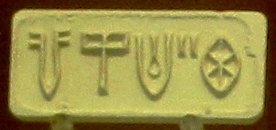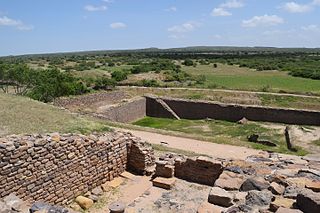World timeline

The Bronze Age in the Indian subcontinent begins around 3000 BCE, and in the end gives rise to the Indus Valley Civilisation, which had its (mature) period between 2600 BCE and 1900 BCE. It continues into the Rigvedic period, the early part of the Vedic period. It is succeeded by the Iron Age in India, beginning in around 1000 BCE.
South India, by contrast, remains in the Mesolithic stage until about 2500 BCE. In the 2nd millennium BCE, there may have been cultural contact between North and South India, even though South India skips a Bronze Age proper and enters the Iron Age from the Chalcolithic stage directly. In February 2006, a school teacher in the village of Sembian-Kandiyur in Tamil Nadu discovered a stone celt with an inscription estimated to be up to 3,500 years old. [1] [2] Indian epigraphist Iravatham Mahadevan postulated that the writing was in Indus script and called the find "the greatest archaeological discovery of a century in Tamil Nadu". [1]
| Date range | Phase | Era |
| 3300-2600 | Early Harappan (Early Bronze Age) | Regionalisation Era c. 4000-2500/2300 BCE (Shaffer) [3] c. 5000-3200 BCE (Coningham & Young) [4] |
|---|---|---|
| 3300-2800 | Harappan 1 (Ravi Phase) | |
| 2800-2600 | Harappan 2 (Kot Diji Phase, Nausharo I, Mehrgarh and Vinya VII) | |
| 2600-1900 | Mature Harappan (Indus Valley Civilisation) | Integration Era |
| 2600-2450 | Harappan 3A (Nausharo II) | |
| 2450-2200 | Harappan 3B | |
| 2200-1900 | Harappan 3C | |
| 1900-1300 | Late Harappan (Cemetery H); Ochre Coloured Pottery | Localisation Era |
| 1900-1700 | Harappan 4 | |
| 1700-1300 | Harappan 5 | |


Harappa is an archaeological site in Punjab, Pakistan, about 24 km (15 mi) west of Sahiwal. The Bronze Age Harappan civilisation, now more often called the Indus Valley Civilisation, is named after the site, which takes its name from a modern village near the former course of the Ravi River, which now runs 8 km (5.0 mi) to the north. The core of the Harappan civilization extended over a large area, from Gujarat in the south, across Sindh and Rajasthan and extending into Punjab and Haryana. Numerous sites have been found outside the core area, including some as far east as Uttar Pradesh and as far west as Sutkagen-dor on the Makran coast of Baluchistan, not far from Iran.

The Indus Valley Civilisation (IVC), also known as the Indus Civilisation was a Bronze Age civilisation in the northwestern regions of South Asia, lasting from 3300 BCE to 1300 BCE, and in its mature form 2600 BCE to 1900 BCE. Together with ancient Egypt and Mesopotamia, it was one of three early civilisations of the Near East and South Asia, and of the three, the most widespread. Its sites spanned an area from much of Pakistan, to northeast Afghanistan, and northwestern India. The civilisation flourished both in the alluvial plain of the Indus River, which flows through the length of Pakistan, and along a system of perennial monsoon-fed rivers that once coursed in the vicinity of the Ghaggar-Hakra, a seasonal river in northwest India and eastern Pakistan.

The Indus script, also known as the Harappan script, is a corpus of symbols produced by the Indus Valley Civilisation. Most inscriptions containing these symbols are extremely short, making it difficult to judge whether or not they constituted a writing system used to record the as-yet unidentified language(s) of the Indus Valley Civilisation. Despite many attempts, the 'script' has not yet been deciphered, but efforts are ongoing. There is no known bilingual inscription to help decipher the script, and the script shows no significant changes over time. However, some of the syntax varies depending upon location.

The following outline is provided as an overview of and topical guide to ancient India:

The Gandhara grave culture, also called Swat Protohistoric Graveyards Complex, was an Indo-Aryan culture which emerged c.1200 BCE, and lasted until 800 BCE, as recent fieldwork, along with subsequent analyses, have shown there are no burials with these features after 800 BCE. It is found in Middle Swat River course, even though earlier research considered it to be expanded to the Valleys of Dir, Kunar, Chitral, and Peshawar. It has been regarded as a token of the Indo-Aryan migrations, but has also been explained by local cultural continuity. Estimates, based on ancient DNA analyses, suggest ancestors of Swat people mixed with a population coming from the Inner Asian Mountain Corridor, which carried Steppe ancestry, sometime between 1900 and 1500 BCE.

Dholavira is an archaeological site at Khadirbet in Bhachau Taluka of Kutch District, in the state of Gujarat in western India, which has taken its name from a modern-day village 1 kilometre (0.62 mi) south of it. This village is 165 km (103 mi) from Radhanpur. Also known locally as Kotada timba, the site contains ruins of a city of the ancient Indus Valley civilization. Earthquakes have repeatedly affected Dholavira, including a particularly severe one around 2600 BC.
Several periodisations are employed for the periodisation of the Indus Valley Civilisation. While the Indus Valley Civilisation was divided into Early, Mature, and Late Harappan by archaeologists like Mortimer Wheeler, newer periodisations include the Neolithic early farming settlements, and use a stage–phase model, often combining terminology from various systems.

In the prehistory of the Indian subcontinent, the Iron Age succeeded Bronze Age India and partly corresponds with the megalithic cultures of India. Other Iron Age archaeological cultures of India were the Painted Grey Ware culture and the Northern Black Polished Ware. This corresponds to the transition of the Janapadas or principalities of the Vedic period to the sixteen Mahajanapadas or region-states of the early historic period, culminating in the emergence of the Maurya Empire towards the end of the period.

Tamiḻakam refers to the geographical region inhabited by the ancient Tamil people, covering the southernmost region of the Indian subcontinent. Tamilakam covered today's Tamil Nadu, Kerala, Puducherry, Lakshadweep and southern parts of Andhra Pradesh and Karnataka. Traditional accounts and the Tolkāppiyam referred to these territories as a single cultural area, where Tamil was the natural language and permeated the culture of all its inhabitants. The ancient Tamil country was divided into kingdoms. The best known among them were the Cheras, Cholas, Pandyans and Pallavas. During the Sangam period, Tamil culture began to spread outside Tamilakam. Ancient Tamil settlements were also established in Sri Lanka and the Maldives (Giravarus).

The South Asian Stone Age covers the Palaeolithic, Mesolithic and Neolithic periods in South Asia. Evidence for the most ancient Homo sapiens in South Asia has been found in the cave sites of Cudappah of India, Batadombalena and Belilena in Sri Lanka. In Mehrgarh, in what is today western Pakistan, the Neolithic began c. 7000 BCE and lasted until 3300 BCE and the first beginnings of the Bronze Age. In South India, the Mesolithic lasted until 3000 BCE, and the Neolithic until 1400 BCE, followed by a Megalithic transitional period mostly skipping the Bronze Age. The Iron Age began roughly simultaneously in North and South India, around c. 1200 to 1000 BCE.

Tamil-Brahmi, also known as Tamizhi or Damili, was a variant of the Brahmi script in southern India. It was used to write inscriptions in the early form of Old Tamil. The Tamil-Brahmi script has been paleographically and stratigraphically dated between the third century BCE and the first century CE, and it constitutes the earliest known writing system evidenced in many parts of Tamil Nadu, Kerala, Andhra Pradesh and Sri Lanka. Tamil Brahmi inscriptions have been found on cave entrances, stone beds, potsherds, jar burials, coins, seals, and rings.

Bhirrana, also Bhirdana and Birhana, is an archaeological site, located in a small village in Fatehabad District, in the Indian state of Haryana. Bhirrana's earliest archaeological layers predates Indus Valley civilisation times, dating to the 8th-7th millennium BCE. The site is one of the many sites seen along the channels of the seasonal Ghaggar river, thought by some to be the Rigvedic Saraswati river.

The earliest undisputed deciphered epigraphy found in the Indian subcontinent are the Edicts of Ashoka of the 3rd century BCE, in the Brahmi script.

Iravatham Mahadevan was an Indian epigraphist and civil servant, known for his decipherment of Tamil-Brahmi inscriptions and for his expertise on the epigraphy of the Indus Valley civilisation.

The Dravidian peoples, or Dravidians, are an ethnolinguistic and cultural group living in South Asia who predominantly speak any of the Dravidian languages. There are around 250 million native speakers of Dravidian languages. Dravidian speakers form the majority of the population of South India and are natively found in India, Pakistan, Afghanistan, Bangladesh, the Maldives, Nepal, Bhutan and Sri Lanka. Dravidian peoples are also present in Singapore, Mauritius, Malaysia, France, South Africa, Myanmar, East Africa, the Caribbean, and the United Arab Emirates through recent migration.
Sembiyankandiyur is an archaeological site in Nagapattinam district in Tamil Nadu, India.

Keezhadi is a village near the village of Silaiman, on the border between Madurai and Sivagangai districts, in Tamil Nadu, India. The Keezhadi excavation site is located in this area: excavations carried out by the Archaeological Survey of India (ASI) and the Tamil Nadu Archaeology Department (TNAD) have revealed a Sangam era settlement dated to the 6th century BCE by radiocarbon dating. Claims that the results show that there was writing at that time have been challenged. It is not clear whether the potsherds containing inscriptions were found in the same archaeological layer as the 6th century samples, and University of Calcutta archaeologist Bishnupriya Basak said that "This unfortunately is not clear from the report and is very crucial", adding that the issues of "layer, period and absolute dates" needed clarity. Dravidian University archaeologist E. Harsha Vardhan said that a single report was not enough to "state scientifically that the Tamil-Brahmi script belongs to the sixth century BC".
Megalithic markings, megalithic graffiti marks, megalithic symbols or non-Brahmi symbols are markings found on mostly potsherds found in Central India, South India and Sri Lanka during the Megalithic Iron Age in India. A number of scholars have tried to decipher the symbols since 1878, and currently there is no consensus as to whether they constitute undeciphered writing or graffiti or symbols without any syllabic or alphabetic meaning.

Keezhadiexcavation site is a Sangam age settlement that is being excavated by the Archaeological Survey of India and the Tamil Nadu State Department of Archaeology. This site is located 12 km southeast of Madurai in Tamil Nadu, near the town of Keezhadi in Sivagangai district. It comes under the Thiruppuvanam Taluk of Sivagangai district. This is a large-scale excavation carried out in Tamil Nadu after the Adichanallur archaeological site. The settlement lies on the bank of the Vaigai River and it reflects the ancient culture of Tamil people. Epigraphist V. Vedachalam, who served as a domain expert for the excavation, dated the excavated remains between 6th century BCE and 3rd century CE.

This is a list of archaeological artefacts and epigraphs which have Tamil inscriptions. Of the approximately 100,000 inscriptions found by the Archaeological Survey of India in India, about 60,000 were in Tamil Nadu
{{cite news}}: CS1 maint: unfit URL (link)